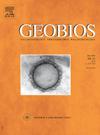伊比利亚西北部 Raricostatum 区(Aplanatum 亚区)Echioceratidae(Amonitina)的生物时层图和古生物地理学
IF 1.6
4区 地球科学
Q2 PALEONTOLOGY
引用次数: 0
摘要
本文研究了伊比利亚西北部记录到的最上新(Sinemurian)期和最下普利恩巴赫(Pliensbachian)期的鹦鹉螺动物群,特别关注 Aplanatum 亚区的 Echioceratidae。总共从阿斯图里亚斯、巴斯克-坎塔布里亚和卢西坦盆地的五个参考剖面逐层采集了 852 个标本。样本中 Echioceratidae(即 Paltechioceras 属)占 86.2%,Polymorphitidae(Leptonotoceras 属)占 10%,Eoderoceratidae、Phricodoceratidae 或 Oxynoticeratidae 标本不足 4%。本研究描述了五种 Paltechioceras,即 P. tardecrescens、P. oosteri、P. recticostatum、P. elicitum 和 P. romanicum。通过它们可以对所研究的盆地进行生物年代地层划分,并在全球范围内进行相关划分。其中一个物种,P. romanicum,是所有研究剖面中记录的最晚的物种,出现在新元古代-渐新巴赫期边界的正下方。这一分布广泛的物种的消失标志着贻贝类的灭绝。本研究回顾了围绕新志留纪-皮邻巴奇纪过渡时期所发生的全球性事件(新志留纪-皮邻巴奇纪边界事件)。最后,我们对所描述的Paltechioceras物种进行了古生物地理学分析,为讨论新元古代晚期西班牙走廊的开辟提供了更多信息。本文章由计算机程序翻译,如有差异,请以英文原文为准。
Biochronostratigraphy and palaeobiogeography of Echioceratidae (Ammonitina) from the Raricostatum Zone (Aplanatum Subzone) in NW Iberia
This paper examines the uppermost Sinemurian and lowermost Pliensbachian ammonite fauna recorded in NW Iberia with a special focus on Echioceratidae from the Aplanatum Subzone. In total, 852 specimens have been collected bed-by-bed from five reference sections from the Asturian, Basque-Cantabrian, and Lusitanian basins. Echioceratidae, namely Paltechioceras genus, represent 86.2% of the sample, Polymorphitidae (Leptonotoceras genus) the 10%, and less than 4% of the specimens are Eoderoceratidae, Phricodoceratidae, or Oxynoticeratidae. This study describes five species of Paltechioceras, namely P. tardecrescens, P. oosteri, P. recticostatum, P. elicitum, and P. romanicum. They allow a biochronostratigraphic division for the studied basins and its worldwide correlation. One of the species, P. romanicum, is the latest one registered in all the studied sections, occurring directly below the Sinemurian–Pliensbachian boundary. The disappearance of this widely distributed species marks the echioceratids extinction. This work reviews the global events described around the Sinemurian–Pliensbachian transition (the Sinemurian–Pliensbachian boundary event). Finally, we present a palaeobiogeographical analysis of the Paltechioceras species described, giving more information to discuss the opening of the Hispanic Corridor during the late Sinemurian.
求助全文
通过发布文献求助,成功后即可免费获取论文全文。
去求助
来源期刊

Geobios
地学-古生物学
CiteScore
3.30
自引率
6.20%
发文量
28
审稿时长
6-12 weeks
期刊介绍:
Geobios publishes bimonthly in English original peer-reviewed articles of international interest in any area of paleontology, paleobiology, paleoecology, paleobiogeography, (bio)stratigraphy and biogeochemistry. All taxonomic groups are treated, including microfossils, invertebrates, plants, vertebrates and ichnofossils.
Geobios welcomes descriptive papers based on original material (e.g. large Systematic Paleontology works), as well as more analytically and/or methodologically oriented papers, provided they offer strong and significant biochronological/biostratigraphical, paleobiogeographical, paleobiological and/or phylogenetic new insights and perspectices. A high priority level is given to synchronic and/or diachronic studies based on multi- or inter-disciplinary approaches mixing various fields of Earth and Life Sciences. Works based on extant data are also considered, provided they offer significant insights into geological-time studies.
 求助内容:
求助内容: 应助结果提醒方式:
应助结果提醒方式:


